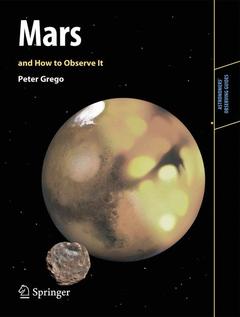Description
Mars and How to Observe It, 2012
Astronomers' Observing Guides Series
Author: Grego Peter
Language: English
Subject for Mars and How to Observe It:
238 p. · 17.8x23.5 cm · Paperback
Description
/li>Contents
/li>Biography
/li>Comment
/li>
Mars, popularly known as the Red Planet because of its distinct color, is visible with the naked eye and is one of very few planets in the Solar System in which it is possible to see weather phenomena and surface features and thus is a favorite for amateur and practical astronomers. Commercially made telescopes can reveal its dusty surface markings, brilliant polar ice caps, and atmospheric phenomena. Many of Mars's features appear to change shape and intensity with the seasons: its polar caps grow and shrink cyclically, clouds billow above the Martian surface, and sometimes great dust storms obscure vast sections of the planet.
The first part of Mars and How to Observe It sets out our current knowledge of Mars as a planet - its orbit, physical characteristics, evolution over time, and current geology. A planet-wide tour of Mars's topography is featured, along with clearly labeled maps and close-up images of a variety of features. The second part of the book explains how amateur and practical astronomers can observe Mars successfully. Many aspects are considered in depth, including preparing to observe, calculating phase and tilt, and making observational sketches and drawings. There are also plenty of details about how best to make high-resolution CCD images. Since Mars changes in its apparent size in the sky according to its position in relation to Earth, it is best observed during its closest approaches. Future apparitions (appearances of the Red Planet) are therefore featured.
About the Author.- Introduction.- Section I: Our Current Knowledge of Mars.- Chapter 1: Fourth Rock from the Sun.- Chapter 2: History of the Red Planet.- Chapter 3: Stuff and Substance.- Chapter 4: Atmospherics, Meteors, and Magentic Field.- Chapter 5: The Martian Moons.- Chapter 6: A Topographic Survey of Mars.- Section II: Observing Mars.- Chapter 7: Following Mars.- Chapter 8: A Tour of Mars.- Chapter 9: Recording Mars.- Chapter 10: An Observer's Guide to Martian Apparitions.- Chapter 11: The Mars Observer's Equipment.- Glossary.- Index.
Peter Grego is an astronomy writer and editor. A regular watcher of the night skies since 1976, he observes from his home in St. Dennis, Cornwall, UK, with a variety of instruments. His telescopes include a 102 mm refractor, home-made 150 mm and 300 mm Newtonians (telescope mirror-making is another of his interests) and a 445 mm Newtonian, but his most-used instrument is his 200 mm SCT. Grego’s primary observing interests are the Moon’s topography, Mars and Jupiter. He now likes to use a hand-held computer to make observational drawings.
Grego has directed the Lunar Section of Britain’s Society for Popular Astronomy (SPA) since 1984, and since 2006 has been actively involved with the Lunar Section of the British Astronomical Association (BAA). He edits and produces four astronomy publications – Luna (journal of the SPA Lunar Section), The BAA Lunar Section Circulars and Popular Astronomy magazine. He is also layout editor for the Bulletin of the Society for the History of Astronomy and The Antiquarian Astronomer.
Grego’s astronomical writings and observations have been featured in many publications since 1983, including the BAS Newsletter, Popular Astronomy, The New Moon, Amateur Astronomy and Earth Sciences, Gnomon, The Lunar Observer, Yokohama Science Center News, and the CD-ROM Window on the Universe. Since 1997 he has written and illustrated the monthly MoonWatch page in UK’s Astronomy Now magazine, and he is the observing advisor and columnist for the Sky at Night magazine.
He has given many talks to astronomical societies around the UK and has been featured on a number of radio and television broadcasts.
Grego is the author of numerous astronomy books, including Collision:Earth! (Cassell, 1998), Moon Observer’s Guide (Philips/Firefly, 2004), The Moon and How to Observe It (Springer, 2005), Need to Know? Stargazing (Collins, 2005), Need to Know? Universe (Collins, 2006),Solar System Observer’s




